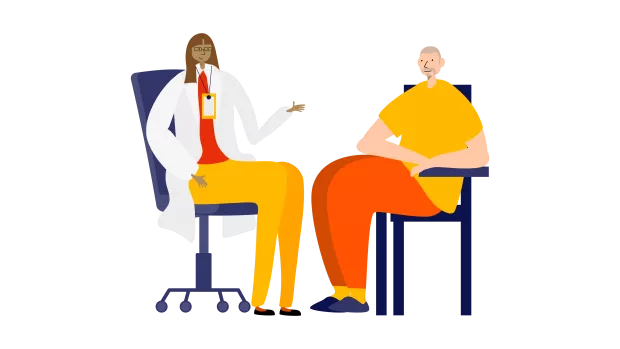
Alemtuzumab (Lemtrada)
Alemtuzumab is a disease modifying therapy (DMT) for relapsing MS. Its brand name is Lemtrada and you take it as an infusion.
Read the latest information about DMTs and coronavirus COVID-19
The European Medicine Agency (EMA) has investigated some very rare side effects of this treatment. Read more about the safety review.
- Who can take alemtuzumab (Lemtrada)?
- How does alemtuzumab (Lemtrada) work?
- How well does alemtuzumab (Lemtrada) work?
- What are the side effects of alemtuzumab (Lemtrada)?
- Alemtuzumab (Lemtrada) and pregnancy, breastfeeding and contraception
Who can take alemtuzumab (Lemtrada)?
Across the UK you can take alemtuzumab (brand name: Lemtrada) if you have relapsing MS and:
- despite already taking a DMT, you’ve still had a recent relapse and MRI scans show new signs that your MS is active (you have new lesions)
or
- you’ve had two or more relapses in the last year and you have new lesions on your MRI scans (whether you’re already on a DMT or not).
How does alemtuzumab (Lemtrada) work?
Alemtuzumab (Lemtrada) kills certain types of cells made by your immune system. Called T and B cells they normally attack viruses and bacteria that get into your body. But in MS these cells attack the covering around the nerves (called myelin) in your brain and spinal cord. Alemtuzumab stops these cells from getting into your brain and spinal cord before they can damage the nerves there.
Most people only need to take the drug twice, in two courses spaced a year apart from each other. It's given through a drip (known as an infusion) in hospital.
For the first course you go to hospital five days in a row. Each day you have an infusion that takes about four hours. You might go home every day two hours after your infusion or you may stay in hospital for the length of the treatment.
You have the second course a year later, over three days in a row, again for about four hours each day. Most people don't need treating again but some might need a third, or even fourth, course. Again, this will be over three days in a row, for about four hours each day.
How well does alemtuzumab (Lemtrada) work?
MS drugs can be put into three groups based on how well they control it. The effect alemtuzumab (Lemtrada) has in controlling MS is classed as 'high', the best of the three groups. This is based on how much it reduces relapses and slows down the rate at which people's disability gets worse.
Relapses dropped by:
50-55% compared to beta interferons
This means that in trials, on average, people saw a 50-55% drop in the number of relapses they had (compared to people who took beta interferons).
Disability getting worse was slowed down by:
up to 42% compared to beta interferons
This means that in one trial, on average, people saw a drop of up to 42% in the risk of their disability getting worse (compared to people who took beta interferons).
In another trial people taking alemtuzumab saw a drop in the risk of their disability getting worse of 30%. But this wasn't big enough to be 'significant'. In other words, it could've happened by chance and not because of the drug.
What are the side effects of alemtuzumab (Lemtrada)?
Compared to other MS drugs the risk of side effects, especially serious ones, is among the highest.
Side effects include infections of your chest, throat, urinary tract and sinuses (the spaces around your nose). After an infusion most people get one or more of these: headaches, rash, hives (a skin rash), feeling or being sick, fever, itching, going red in the face and neck, and feeling tired. These usually soon go away.
More serious side effects include developing a thyroid problem (up to four in 10 people get this). It's treatable but needs lifelong medication. You can still keep taking alemtuzumab.
One to three people in a hundred get a problem with their blood called ITP (immune thrombocytopenia). It can be very serious but it's treatable if caught early by a blood test. Symptoms include bruising and bleeding too easily.
In the last few years new rare but serious side effects have also been seen. Because of these the European Medicine Agency (EMA) has reviewed the safety of this drug and placed restrictions on who gets it. These new side effects can affect your heart, blood vessels and immune system. They could also affect your blood, lungs and liver.
Everyone who's taken alemtuzumab will have tests for side effects for four years after their last infusion. They'll be monitored for problems with their thyroid and blood. Your health care team should also tell you what to look out for and what to do if you notice any signs or symptoms of these problems.
Because this drug can harm unborn babies, you shouldn’t take it if you’re pregnant, or if you’re trying for a baby or not using contraception. It’s important to protect against pregnancy during each course of treatment and for four months afterwards.
Find more details on side effects and pregnancy in our alemtuzumab factsheet.
Alemtuzumab (Lemtrada) and pregnancy, breastfeeding and contraception
Pregnancy
Alemtuzumab (Lemtrada) might harm unborn babies. So you mustn’t get pregnant while being treated with this drug, or for four months after your final infusion. Four months is this drug’s ‘washout period’. That’s how long it takes for levels of it in your body to reach a level where it’s safe to get pregnant.
Alemtuzumab can be a good choice if you want children because once four months have passed since your final infusion, you can safely get pregnant in the years that follow.
If you and your partner want to have a child, discuss this with your neurologist. If you think you’ve become pregnant, let your medical team know at once. Never stop your DMT without first getting their advice.
Breastfeeding
Alemtuzumab (Lemtrada) might get into breast milk. So you can’t feed a baby this way while on this treatment or for four months after your final infusion.
Contraception
If you can get pregnant, you’ll need reliable contraception (like the ‘pill’, condoms, an IUD or implant) while you’re being treated with this drug and for four months after your final infusion.


